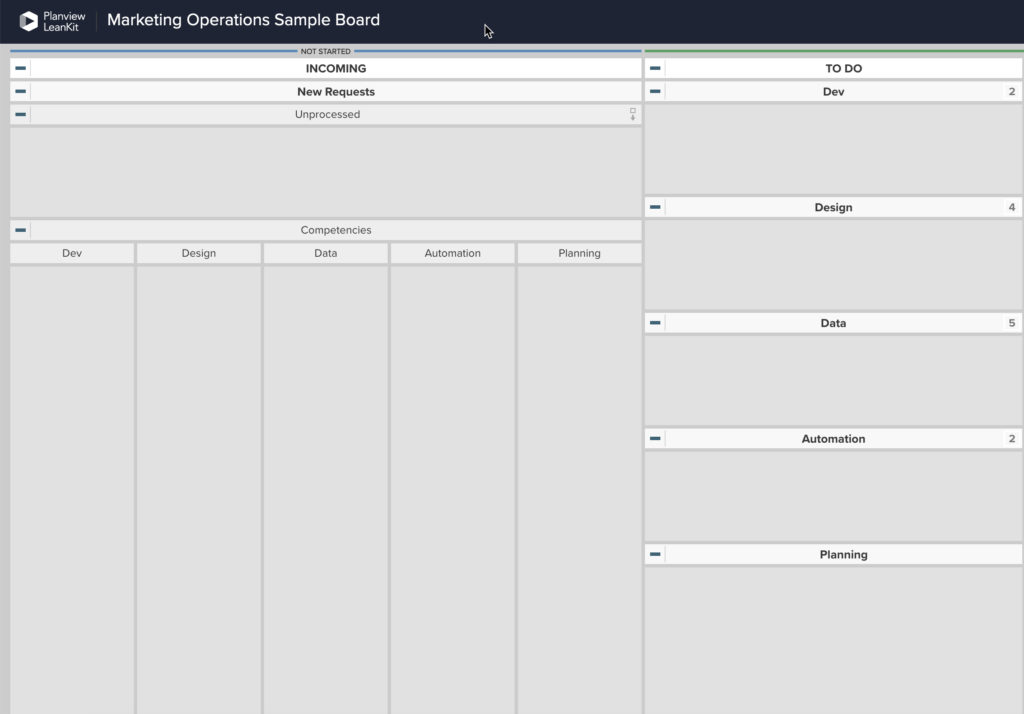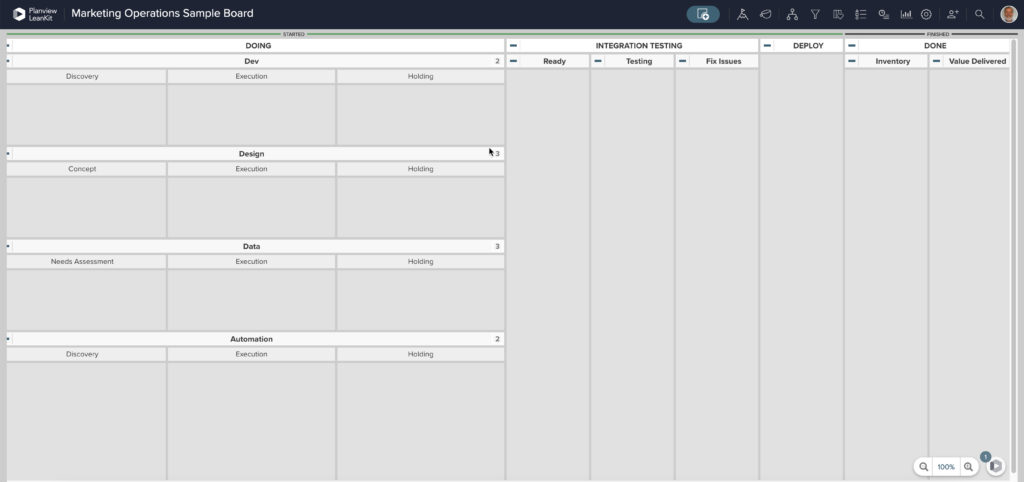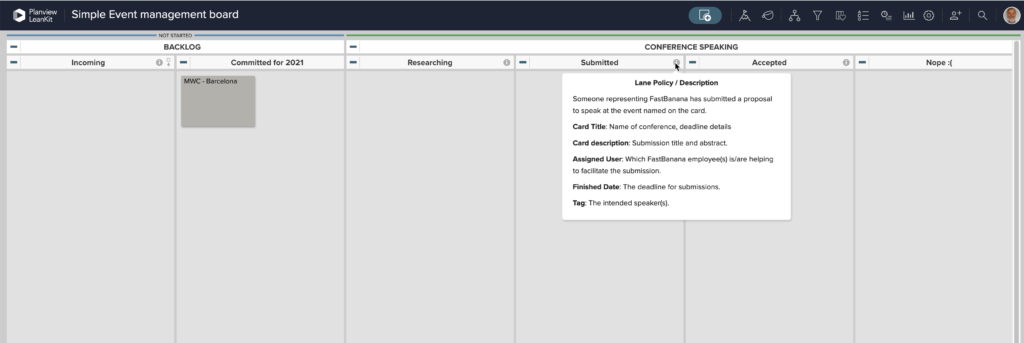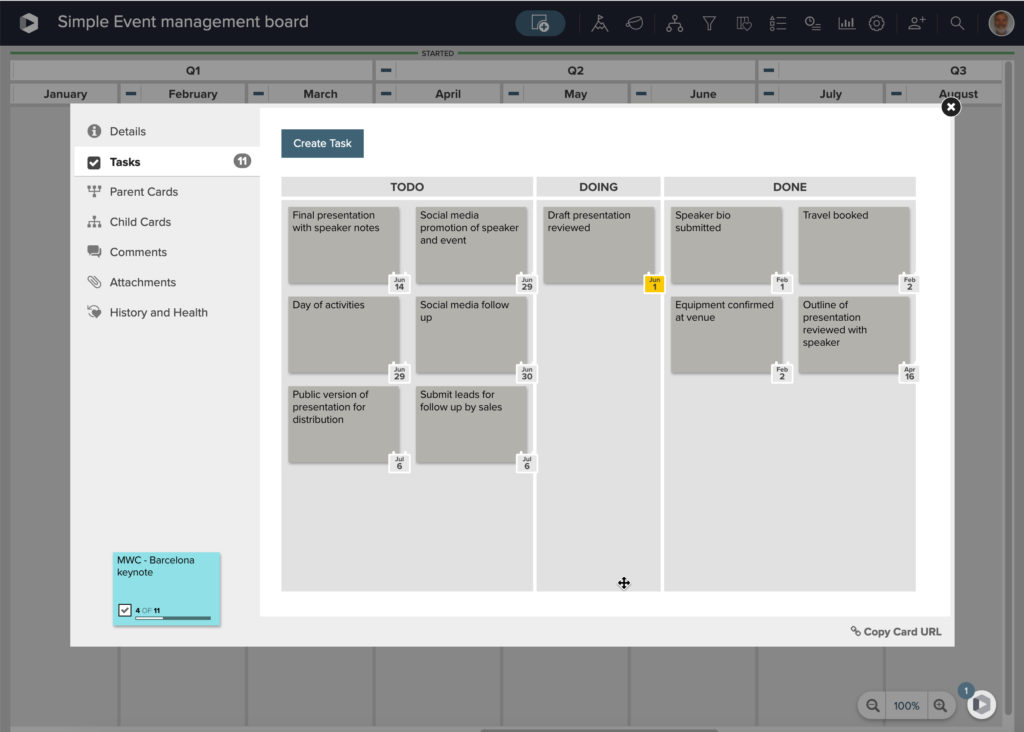
Editor’s Note: For this post on Kanban board templates for Agile marketing, we’re excited to welcome Jim Ewel to the Planview blog. As one of the leading voices on Agile marketing, Jim co-organized the first meeting of Agile marketers and co-authored the Agile Marketing Manifesto.
Since 2010, he has helped over 70 organizations adopt Agile to their marketing practice using the approach in his best-selling book, The Six Disciplines of Agile Marketing. Today, his blog is one of the most trusted sources on Agile. Jim runs an Agile marketing consultancy, where he helps organizations adopt Agile marketing.
***
How do you create Kanban boards for Agile marketing? What should the flows look like for common marketing functions like content marketing, demand generation, marketing operations, product marketing, events, and PR and social media?
How do you combine multiple marketing disciplines into high-level boards that allow management to see the entirety of marketing initiatives and to drill down to the status of individual deliverables? How do you create boards that show how tactics relate to strategy and allow CMOs and other senior leaders to see a high-level view of execution of strategic initiatives?
I’ll answer those questions and more in a series of blog posts. For this post, the first in the series, I’m going to take a look at the first two questions and discuss eight board designs that teams can use as Kanban board templates for Agile marketing in Planview AgilePlace™. You can download the templates here. I’ll also talk about some of the differences in how boards are constructed depending on which Agile methodology you’re practicing: Scrum, Kanban, or Scrumban.
Simple Scrum Board

This simple Scrum board has four columns. You’ve probably seen the simplest Kanban board, which has just three columns: “To Do,” “Doing,” and “Done.” We’ve renamed the “To Do” column “Sprint Backlog” to reflect that this column is a subset of our entire backlog, including only those deliverables or tasks that we’ve committed to do during this Sprint.
We’ve also added another column, “Reviewing,” for two reasons. First, we may want to put a work-in-process (WIP) limit on the “Reviewing” column because the review stage is often a bottleneck in many Agile marketing organizations. A WIP limit is a constraint that Agile teams put on themselves to encourage getting things done, rather than having items pile up at the review stage. Second, we may want to track the percentage of our entire flow that is spent on review.
Let’s say on average, items in our Sprint backlog take eight days to move from start to done, a measurement known as cycle time. But let’s say that 50% of our cycle time, or an average of four days, is spent on review. If we can get most items reviewed within one day, we can reduce our average cycle time from eight days to five days (four days of doing and one day of review). That’s a huge improvement!
One note: Although I’ve called this board a Simple Scrum Board, the tradition is to name Scrum boards based on the number of Sprints since you’ve started practicing Agile, starting with zero. Your first Sprint is Sprint Zero and the board is named Sprint Zero, the second Sprint is Sprint One and the board is named Sprint One, and so forth.
Simple Scrumban Board

Many marketers think of Scrumban as simply a mashup of the greatest hits of Scrum and Kanban. It is, however, much more than that. Scrumban is a methodology in its own right.
One of the most useful features of Scrumban for marketers is the use of a “Ready” queue. Rather than doing complex Sprint planning, Scrumban teams do lightweight planning whenever the “Ready” queue drops below a certain threshold.
For example, let’s say that you’ve been practicing Scrum for some time, and based on your experience, you know that your team completes about 20 items per week. Some weeks you complete less because you have larger items that take more time, and some weeks you complete more, because you have a mix of smaller items.
You’re finding that your Sprint planning sessions, which take one to two hours every two weeks with story point estimating, planning poker, and other Sprint planning activities, don’t add much value. You might decide to move to Scrumban. Teams that practice Scrumban plan only when and as much as necessary to deliver value.
Instead of Sprint themes and story point estimates and all of the rest, these teams meet only when the Ready queue starts to get depleted. Then they meet for 30-60 minutes to add just enough items to replenish the “Ready” queue.
For example, you might meet whenever the number of items in the “Ready” queue drops to five or less, and then you add enough items to bring the number of items in the Ready queue up to 20. You never have to reset your board. You don’t have groups that are disappointed because you didn’t get everything done during the Sprint. And you probably only spend half the time or less in planning. That’s time that you can spend finishing new work, creating value for the customer.
Content Marketing

In this board, we’ve expanded our central flow from just two columns, “Doing” and “Review,” to seven columns. Why do we do this? Again, two reasons.
We may want to have more detail about the status of the work item than simply seeing it’s somewhere in either the doing or the reviewing stage. For example: Is it on the first draft or second draft? Is it in executive review or legal and compliance review?
Second, we may want to add WIP limits and track the percentage of time spent in each column so we can identify bottlenecks and areas for improvement, just as we did in the Simple Scrum Board above. By having a more detailed flow, we arm ourselves with more knowledge of where the bottlenecks or slowdowns are occurring.
We can also identify content categories with card colors, such as yellow for blog posts, green for eBooks, purple for video, etc.
Demand Generation

This board is a little more complex. It’s the first time we’ve used swimlanes, or the horizontal lanes in this board that divide demand generation activities into three groups: Baseline, Emerging, and Experimental. These three categories are often used by companies that are applying the 70-20-10 rule of marketing innovation. The 70-20-10 rule means:
- About 70% of your marketing budget goes to baseline activities; i.e., activities that have worked well in the past. You may still be optimizing some of the campaigns, but they are using well-understood channels and proven approaches.
- About 20% of your budget goes to emerging channels or approaches. For example, perhaps you are experimenting with uses of AI, or new channels like Clubhouse.
- About 10% of your budget is reserved for experiments. These would include totally new channels or approaches that your competitors aren’t yet trying and that will produce the innovation that will help you rise to or remain at the top of your product category. Many of these experiments will fail, but the ones that work will form the basis of your 70% spend in the future.
We could use color coding to identify the three categories of the 70-20-10 rule, but I prefer to use swimlanes. I prefer to use color coding in this board to identify either content types or channels (blue for LinkedIn, green for Facebook, etc). I also think that the swimlanes are easier to read.
The workflow in the main work-in-progress section is simple: plan, create, review, and finalize. You could keep it this simple, or you could add a few more stages to reflect the actual steps involved in your particular workflow. Neither is good or bad — the key is to focus on what allows you to track progress and identify bottlenecks.
Note that we’ve also divided our “Done” column into three sub-columns — “In Market,” “Complete,” and “Learnings.” You want to make sure that you document your learnings for all demand generation campaigns and this last section ensures that this gets done.
Marketing Operations
Marketing operations can sometimes be straightforward or complex. For example, creating a new email sequence in most marketing automation tools is generally straightforward for those who have been trained in the use of the tool.
On the other hand, implementing a new MarTech stack, including cleaning up your data, implementing a new marketing automation program, integrating it with your existing CRM, and designing new templates for all emails, landing pages, and other customer-facing content can be quite complex.
This board addresses this complexity. New requests come in. Depending on their complexity, they may move quickly to deliverables and tasks based on various competencies: development, design, data, or automation. More complex implementations may require that a planner break down this project into multiple deliverables, involving all of the various competencies.


In the “Doing” section, multiple swimlanes allow us to see the workflows of each of the various competencies. Although each workflow uses slightly different terminology, the basic stages of the flow include discovery, execution, and holding. The “Holding” column holds work until all the parts are ready for integration.
Integration testing ensures that the work from all the various teams works well together. Then the work is deployed. As a last step, the team evaluates the value delivered by their marketing operations.
Product Marketing

This product marketing board tracks the production of customer-ready materials like sales sheets, product briefs, release notes, and customer-facing product roadmaps. The stages include brief, outline, draft, edit, build, approval, and deploy. It is a subset of a board used by an Agile product management team.
The full board includes sections on internal deliverables, as well as external deliverables. It also has a section for planning that includes categories like webinars, lifecycle management, research, sales enablement, competitive analysis, and product-related materials.
Note that this board has “Done” queues at the end of the outline, edit, and build stages of the workflow. These “Done” queues serve several purposes.
First, whoever is responsible for the next stage in the flow can subscribe to the “Done” column, which lets them know that the previous stage is done, and they can pull the work when they are ready.
Second, by measuring how much time work items spend in these “Done” queues, teams can identify bottlenecks and where work spends excessive amounts of time waiting, indicating that there are not enough resources available in the next stage to pull work in a timely manner.
Last, teams can use these “Done” queues to calculate a metric called flow efficiency. Flow efficiency is the ratio of active time working divided by total time to complete work. The “Done” queues represent time where no one is actively working on the deliverable. For example, if a team spends 10 total days to complete an item, but only two days doing actual work on the item, the flow efficiency is 20%.
Events
People tell me that event management isn’t well suited to Agile. I believe this is primarily due to people associating Agile with Scrum, and they can’t imagine how they would manage events in two-week Sprints. They’re right. Kanban, and specifically Kanban boards, can be used to manage events. Let’s see how.

The three images here are all from a single board that is too wide for a single screen shot. This first section covers requests for new events, events that the organization has committed to, and a flow for tracking conference speaking. We also see an example of a process policy to remind the user that any card must have certain fields filled out.

This second image is essentially a calendar. At a glance, we can see all the events by quarter.

This third image shows the tasks associated with each event. The card is opened up and the tasks are delineated in a simple Kanban board. Every task can be assigned a due date, an owner, a start date, and other information. The board owner can create template cards so that a checklist of tasks is provided for every event to ensure quality. Events can also have tasks unique to that event.
This event management board makes it very easy to manage everything in one place.
PR & Social Media

PR and social media is another area where some people feel that Agile can’t help them manage their work. I beg to differ. Loomly has a great example of a social media workflow. It can be repurposed for PR, or you could create a separate swimlane for PR.
The workflow begins with ideas for social media promotions. Some of those will be accepted, others rejected. The stages of our process for accepted ideas includes asset gathering, copywriting, proofing, approval, revising, scheduling, promotion, engagement with people who respond to our posts, and what we learned. Some of these stages might be skipped, but the flow reminds us to consider each stage.
Next Up: Connecting Boards for High-Level Views
For the next post in this series, I’m going to answer the final two questions posed at the beginning of this post: How do you combine multiple marketing disciplines into high-level boards that allow management to see the entirety of marketing initiatives and to drill down to the status of individual deliverables? And how do you create boards that show how tactics relate to strategy and allow CMOs and other senior leaders to see a high-level view of execution of strategic initiatives?
Read next: Advanced Kanban Board Templates for Agile Marketing
Editor’s Note: If you’d like to use any of the boards in this post as a template in Planview AgilePlace, you can download the templates from Jim’s website. The templates are easy to upload and use. If you’re not a Planview AgilePlace customer yet, then you can try Planview AgilePlace free for 30 days. Consider using one or more of these Kanban board templates for Agile marketing in your trial so you can get started right away with a board that matches your process.




